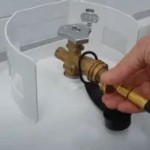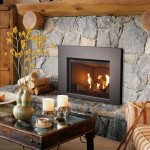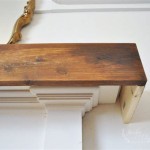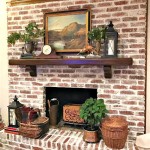Living Room Ideas With TV and Fireplace: Balancing Focal Points
Integrating a television and fireplace into a living room design presents a common challenge: both elements naturally serve as focal points. Successfully combining these competing attractions requires careful consideration of room layout, architectural style, and personal preferences. This article explores various strategies for harmonizing these two elements, creating a cohesive and aesthetically pleasing living space.
The fundamental principle is to establish a visual hierarchy. One element should ideally take precedence, minimizing any sense of competition. This prioritization can be achieved through strategic placement, size considerations, and complementary design elements. Ignoring this principle can lead to a visually cluttered and unbalanced room, where neither the television nor the fireplace truly shines.
Prioritizing the Fireplace: A Traditional Approach
This approach often suits more traditional or rustic architectural styles where the fireplace is a significant architectural feature. The fireplace becomes the primary focal point, and the television is integrated in a way that minimizes its visual dominance. This might involve placing the television to the side of the fireplace, either on a wall-mounted bracket or within a built-in unit. The size of the television should be proportionate to the fireplace, so that it doesn't overpower it.
Another strategy is to conceal the television when it is not in use. Retractable screens, sliding panels, or cabinet doors can effectively hide the television, maintaining the fireplace's central role in the room's aesthetic. When the television is concealed, the room reverts to a more serene and visually calming atmosphere, emphasizing the warmth and ambiance of the fireplace.
Consider the surrounding decor when prioritizing the fireplace. Natural materials like stone, brick, and wood enhance the fireplace's inherent warmth and character. These materials can be repeated in other areas of the room, such as flooring, furniture, or accent walls, creating a cohesive design scheme. Fireplace accessories, like andirons, screens, and mantels, also contribute to its prominence as a focal point.
Lighting also plays a crucial role. Soft, warm lighting around the fireplace can accentuate its textures and colors, drawing the eye and creating a cozy atmosphere. Dimmers allow for adjustments to the lighting level, further emphasizing the fireplace during relaxation periods.
Balancing the TV and Fireplace: A Modern Compromise
In contemporary designs, achieving a balanced aesthetic between the television and fireplace can be more desirable. This involves creating a sense of equality between the two elements, neither dominating the other. This approach demands careful planning and execution to avoid visual clutter.
One effective method is to place both the television and fireplace on the same wall, side by side. Ideally, they should be of similar dimensions or proportions to create a visual balance. A shared mantel or built-in unit can further unify the two elements. The design of the mantel should be simple and uncluttered, avoiding any overly ornate details that could detract from either the television or the fireplace.
Another strategy involves using color and texture to create balance. For example, if the fireplace is made of a dark, dramatic material, the television surround could be painted in a complementary light color to create contrast. Conversely, if the fireplace is simple and understated, the television could be framed by a bold, eye-catching surround.
Consider the viewing angle when arranging furniture. The seating arrangement should allow for comfortable viewing of both the television and the fireplace. This might involve arranging furniture in an L-shape, with one section facing the television and the other facing the fireplace. Alternatively, a sectional sofa can be positioned to offer views of both focal points.
Mounting the TV above the fireplace is a popular space-saving solution. However, this arrangement can present ergonomic challenges, as viewers may experience neck strain from looking upwards for extended periods. Ensure the TV is angled downwards for optimal viewing. Heat from the fireplace can also damage the TV over time, so consult with a professional about heat shielding and proper installation.
Integrating Functionality and Aesthetics
Beyond visual balance, the practical aspects of integrating a television and fireplace should be carefully considered. This includes cable management, adequate ventilation, and accessibility for maintenance.
Cable management is crucial for maintaining a clean and uncluttered look. Wires should be concealed within walls, behind furniture, or in dedicated cable management systems. This prevents unsightly tangles and improves the overall aesthetic of the room.
Adequate ventilation is especially important if a fireplace is wood-burning. Ensure the room has proper ventilation to prevent smoke buildup and carbon monoxide poisoning. Regularly inspect and clean the chimney to maintain optimal performance and safety.
Accessibility for maintenance is often overlooked. When designing built-in units or concealing the television, ensure there is easy access for repairs, cleaning, and upgrades. Avoid creating situations where accessing the television or fireplace requires dismantling sections of the unit.
Consider the type of fireplace. Electric fireplaces offer greater flexibility in terms of placement and installation compared to wood-burning or gas fireplaces. They can be easily incorporated into built-in units and often include features like adjustable heat settings and realistic flame effects. Gas fireplaces provide the ambiance of a traditional fireplace with the convenience of gas fuel. Wood-burning fireplaces offer the most authentic experience but require more maintenance and attention to safety.
Think about surrounding storage. Incorporating storage solutions into the design can help keep the living room organized and clutter-free. Shelving units, cabinets, and drawers can be used to store media equipment, books, and other items, freeing up valuable surface space and enhancing the overall functionality of the room.
Reflective materials can also be strategically used to enhance the room's ambiance. Mirrors placed near the fireplace can reflect the flames, creating a warmer and more inviting atmosphere. Glass shelves or countertops can add a touch of elegance and reflect light, making the room feel brighter and more spacious.
Ultimately, successfully integrating a television and fireplace requires a holistic approach, considering both aesthetic and practical factors. By carefully planning the layout, choosing complementary materials, and addressing functional considerations, a comfortable and visually appealing living space can be created.
The integration process should align with the overall design theme of the living room. Whether the style is modern, traditional, or eclectic, the television and fireplace should seamlessly blend into the existing aesthetic. This may involve choosing materials, colors, and furniture styles that complement the overall design scheme.
Finally, remember to personalize the space. Incorporate personal touches, such as artwork, photographs, and decorative objects, to create a living room that reflects your unique style and personality. These elements can add character and charm to the room, making it a truly inviting and comfortable space.

Tv And Fireplace In One Room Find The Perfectly Happy Spot For That Black Beast Form Design Tasteful Interiors Living Well

Living Room Layouts With Fireplace Tvs Direct Fireplaces

Family Room Ideas Contemporary Living Design Small Modern Rooms

Layout A Living Room With Tv Fireplace Florida Leather Gallery

7 Ways To Rock A Tv And Fireplace Combo

13 Impressive Living Room Ideas With Fireplace And Tv Lmolnar Contemporary Design Family Interior

15 Living Room With Fireplace And Tv Ideas
Interior Designers Reveal The Mistakes You Re Making In A Living Room

Stop Hanging Your Television Over Fireplace
Why A Focal Point Doesn T Always Need To Be Fireplace The Living House
Related Posts








